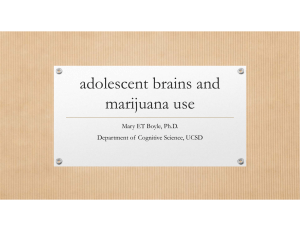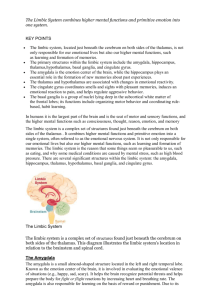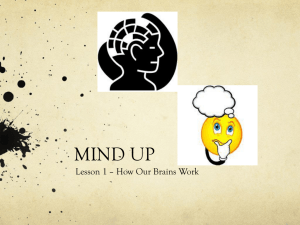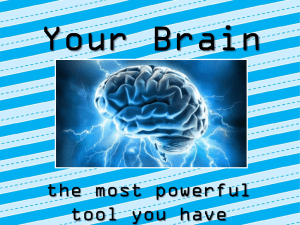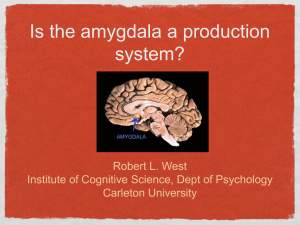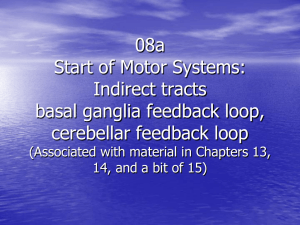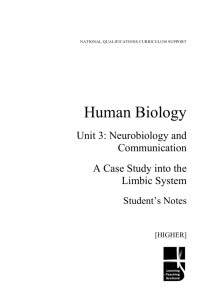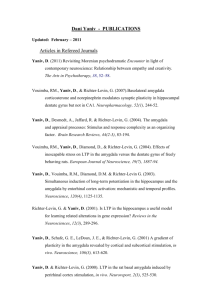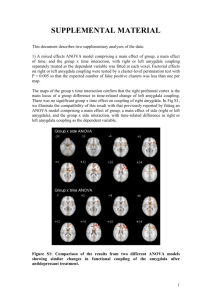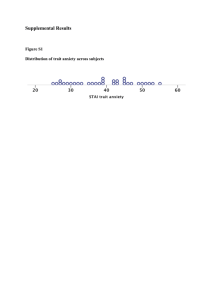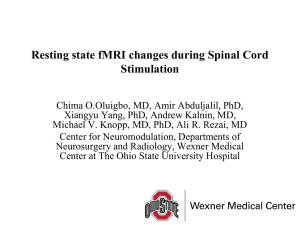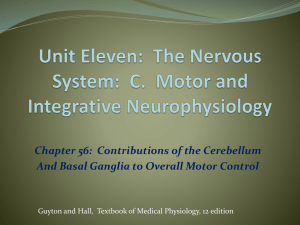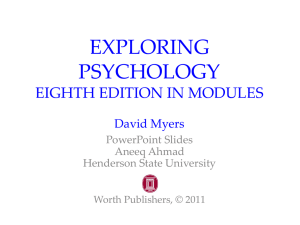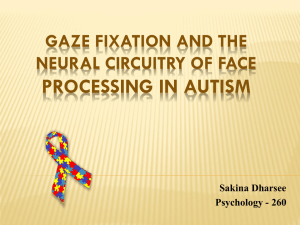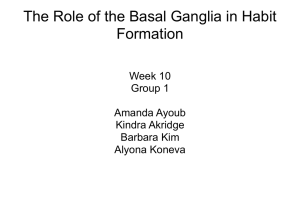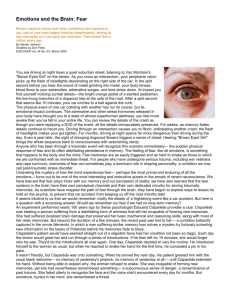Learning - Dot Point 2.
advertisement
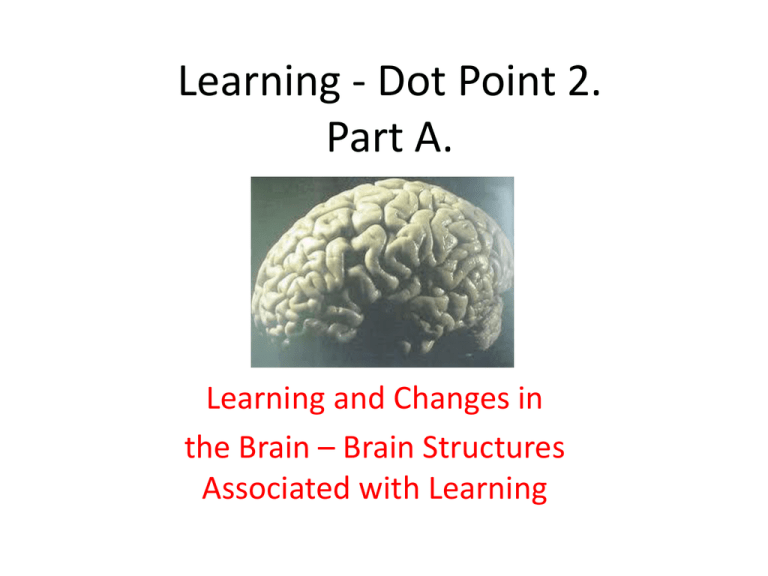
Learning - Dot Point 2. Part A. Learning and Changes in the Brain – Brain Structures Associated with Learning Key Knowledge: Mechanisms of Learning: • Areas of the brain and neural pathways involved in learning, synapse formation, role of neurotransmitters • Developmental plasticity and adaptive plasticity of the brain: changes to the brain in response to learning and experience; timing of experiences • Use of imaging technologies in identification of localised changes in the brain due to learning specific tasks. (VCE Study Design, 2009) Areas of the brain and neural pathways involved in learning, synapse formation, role of neurotransmitters Brain structures involved in learning • Limbic System – Hippocampus – Amygdala • Cerebral cortex – Basal Ganglia • Cerebellum • Midbrain – Ventral tegmental area The Limbic System • The limbic system is composed of a number of structures that form a doughnut-shaped neural system between the hindbrain and the cerebral hemispheres. • Key structures under consideration: – Hippocampus – Amygdala Hippocampus • The hippocampus plays a central role in the mechanism of learning. – Learning new information which will become declarative memory typically involves an interaction between the hippocampus and relevant areas of the cerebral cortex which specialise in storing declarative-type information, such as the occipital lobe for visual memory of written words. • Higher-order animals and humans who have damage to both their left and right hippocampi are able to feel the emotion of fear when they experience pain from a stimulus (for example, an electric shock). • However, they are unable to learn or remember to be fearful the next time they experience a situation in which they will receive the electric shock again. Hippocampus cont. • The hippocampus is involved in learning how to navigate through space. • It is crucial to the formation and storage of episodic memories and it has also been identified as a site for a variety of declarative learning and memory functions. Amygdala • The amygdala has a role in emotional learning—in learning to associate fear with a new unpleasant stimulus. • Stimulation of the amygdala activates the hippocampus and, in humans, learning and memory for pleasant and unpleasant emotional information is linked to the amount of activity in the amygdala when the learning occurs. • In humans and other animals, the amygdala’s main function is to aid survival behaviour, particularly related to aggression and fear (fight–flight). – The amygdala provides a primitive ‘quick pathway’ to the cortex, which enables us to react to dangerous stimuli before we have fully comprehended the situation. Amygdala cont. • When the amygdala is stimulated, animals will respond with aggression or rage • Application: Humans with damage to their amygdala are unable to be classically conditioned (to learn) to fear a dangerous object (stimulus). – This has been shown experimentally with patients. Even if they knew that every time a bell sounds they will receive a shock (Burton et al. 2009) they held no fear. – The amygdala plays a role in a person’s learning to fear bees but if they have damage to their amygdala, they will show no fear towards the bee. Cerebral Cortex – Basal Ganglia • The Basal ganglia is found in the frontal lobes. – It uses information from the primary and secondary motor areas of the frontal lobes, as well as from the somatosensory cortex, to integrate and smooth bodily movements. – Neural Pathways are transferred to the Basal Ganglia and new neural activity is generally activated once a response becomes very well learned and no longer requires much conscious thought. • People who suffer from diseases which damage the basal ganglia, such as Parkinson’s or Huntington’s disease, have great difficulty learning to do tasks which result in non-declarative memory, such as learning skills which result in procedural memory. Cerebellum – ‘little brain’ • The cerebellum is located in the hindbrain and plays a role in the order of muscular movement, balance and posture. • It is also necessary for learning motor skills, as well as contributing to non-motor learning. • The cerebellum is also implicated in neural circuits involved in simple stimulus–response learning (classical conditioning) • The cerebellum and basal ganglia work together in learning movement sequences so that the movements can be carried out together. Midbrain Structure: Ventral Tegmental Area • The ventral tegmental area (VTA) is located in the midbrain • It is thought to have a role in learning through operant conditioning. – In particular, it plays a role in the rewarding effects of primary reinforcers in operant conditioning, for example food or reproduction. Brain development during adolescence • During adolescence in humans, a large amount of development occurs in structures of the brain that have a role in learning: – cerebellum: there is an increase in the number of neurons and synapses in the cerebellum, the part of the brain responsible for balance, muscle tone, and the performance of motor skills – amygdala: the amygdala becomes more active in adolescence – corpus callosum: the corpus callosum thickens and there is an increase in the number of connections between the two hemispheres – frontal lobe, including prefrontal cortex: motor movement and higher order thinking. Putting it all together Brain region Type of learning Neurotransmitters Association areas of the cerebral Recognising sensory stimuli n/a cortex Neural pathways between the sensory Behavioural responses to environmental stimuli n/a association areas of the cerebral cortex and the areas around the motor cortex in the frontal lobe Amygdala Learning an emotional response or the dopamine consequence of a behaviour Hippocampus Learning an association between a stimulus and glutamate response Basal ganglia Well-learned responses, behaviours that require little conscious thought n/a Next Time in Psych 4: Learning • Synapse formation, • The role of neurotransmitters in learning



